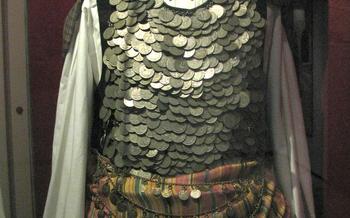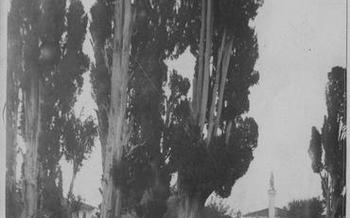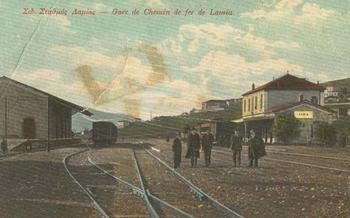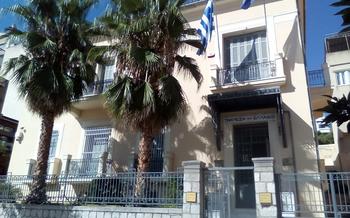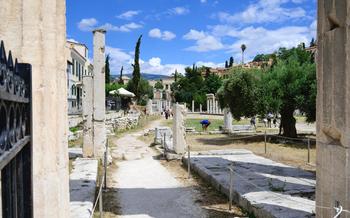
Cave of Loutra Ipatis (Spileo Loutra Ipatis)
- The Cave of Loutra Ipatis: A Journey to the Underworld
- Location and Accessibility
- Guided Tours
- What to Expect Inside the Cave
- Geological Wonders
- Archaeological Treasures
- Mythological Connections
- Historical Importance
- Flora and Fauna
- Cultural Events and Exhibitions
- Surrounding Attractions
- Accessibility for Visitors with Disabilities
- Tips for Planning Your Visit
The Cave of Loutra Ipatis: A Journey to the Underworld
Deep beneath the picturesque town of Lamia in Central Greece lies a hidden gem, the Cave of Loutra Ipatis, also known as Spileo Loutra Ipatis. This subterranean marvel invites you on a journey to the underworld, where awe-inspiring geological formations, significant archaeological discoveries, and captivating mythological tales intertwine.
The cave's history dates back to ancient Greece, when it was revered as a sacred place of worship. Its natural beauty and mystical aura attracted devotees who sought communion with the divine. Over time, the cave became a sanctuary for religious rituals and ceremonies, echoing with prayers and offerings to the gods.
As you delve deeper into the cave's labyrinthine chambers, you'll be mesmerized by the stunning array of stalactites and stalagmites that adorn its walls and ceilings. These intricate formations, sculpted by the patient work of water over millennia, create an otherworldly landscape that seems to defy gravity. The cave's underground rivers and waterfalls add to the ethereal ambiance, their gentle murmur echoing through the vast caverns.
Archaeological excavations within the cave have unearthed a wealth of artifacts from the Neolithic period, shedding light on the earliest human inhabitants of the region. Tools, pottery, jewelry, and other decorative items provide a glimpse into the lives and customs of these ancient people. The cave's significance as an archaeological site extends beyond its Neolithic treasures, as it also contains evidence of human habitation from later periods, including the Bronze Age, Classical Greece, and the Byzantine Empire.
Location and Accessibility
The Cave of Loutra Ipatis is situated in the picturesque town of Loutra Ipatis, in the Phthiotis region of Central Greece. Its geographical coordinates are 38°49'20.0"N 22°14'50"E.
The cave is conveniently located just a short distance from major cities, making it an accessible destination for both domestic and international visitors. It is approximately 150 kilometers from Athens, the capital of Greece, and 100 kilometers from Thessaloniki, the second-largest city in the country.
Reaching the cave is relatively easy, with several transportation options available. Public transport is a convenient choice, with regular bus services connecting Loutra Ipatis to nearby towns and cities. Taxis are also readily available, offering a comfortable and direct mode of transport. For those seeking a more independent mode of travel, rental cars are a great option, allowing for flexibility and the opportunity to explore the surrounding area at your own pace.
Ample parking facilities are available at the cave, ensuring a hassle-free visit for those arriving by car.
Guided Tours
Visitors to the Cave of Loutra Ipatis can enhance their experience by taking a guided tour. Knowledgeable guides lead these tours, providing insights into the cave's history, geology, and mythology. Tours are available in various languages, including English, Greek, and French, to accommodate international visitors.
The duration of the guided tours typically ranges from 45 minutes to an hour, allowing ample time to explore the cave's main chambers and learn about its significant features. The cost of the tours varies depending on the group size and the time of year, but it generally falls within a reasonable range.
Advance booking for guided tours is recommended, especially during peak tourist season or for larger groups. This ensures that visitors can secure a spot on the tour of their preferred time and language. Reservations can be made online or through the cave's information center.
What to Expect Inside the Cave
Stepping into the Cave of Loutra Ipatis is like entering a hidden realm of wonders. The temperature inside the cave remains consistently cool, providing a refreshing contrast to the often sweltering Greek summer heat. The humidity levels are also relatively high, creating a moist and damp environment that contributes to the cave's unique ecosystem.
The terrain inside the cave is uneven and can be challenging to navigate in some areas. Sturdy and comfortable footwear is essential for ensuring a safe and enjoyable exploration. The cave is well-lit with artificial lighting, allowing visitors to appreciate the intricate details of the rock formations and archaeological discoveries. Safety measures are in place throughout the cave, including handrails, signage, and designated walkways. Visitors are advised to follow the marked paths and avoid touching or disturbing the delicate formations.
Photography is permitted inside the cave, but using a flash is prohibited as it can damage the delicate ecosystems and formations. Taking the time to explore the cave at a leisurely pace is highly recommended, allowing visitors to fully appreciate the awe-inspiring beauty and historical significance of this subterranean wonder.
Geological Wonders
The Cave of Loutra Ipatis is a true geological wonderland, showcasing a dazzling array of stalactites, stalagmites, and other unique rock formations. As you wander through the cave, you'll be amazed by the intricate and delicate structures that have been created by water seeping through the limestone over millions of years.
The stalactites, which hang from the ceiling, and the stalagmites, which rise from the floor, come in all shapes and sizes, creating a surreal and otherworldly landscape. Some of the stalactites are so long and thin that they resemble icicles, while others are more massive and bulbous. The stalagmites, on the other hand, often take the form of pillars, columns, or even mushrooms.
In addition to the stalactites and stalagmites, the cave is also home to a number of underground rivers and waterfalls. The sound of the water flowing through the cave adds to the magical atmosphere and creates a sense of tranquility.
The cave is also rich in fossils and minerals. Fossils of ancient plants and animals, such as sea urchins and mollusks, can be found embedded in the rock walls. The cave also contains a variety of minerals, including calcite, quartz, and pyrite. These minerals add to the beauty and diversity of the cave's geological formations.
Archaeological Treasures
The Cave of Loutra Ipatis also boasts a wealth of archaeological treasures that shed light on the ancient civilizations that inhabited the region. During excavations conducted in the cave, archaeologists discovered a treasure trove of artifacts dating back to the Neolithic period, including tools, pottery, jewelry, and other decorative items. These findings provide valuable insights into the daily lives, customs, and beliefs of the early inhabitants of the cave. Moreover, the cave's walls are adorned with ancient Greek inscriptions and carvings, offering glimpses into the religious practices and rituals that took place within the cave. These archaeological discoveries not only enhance our understanding of the cave's historical significance but also contribute to our knowledge of the broader cultural heritage of Greece.
Mythological Connections
The Cave of Loutra Ipatis is steeped in mythological significance, weaving a tapestry of legends and tales that intertwine with the ancient Greek pantheon. According to one myth, the cave served as the birthplace of Zeus, the king of the gods, who was raised in secrecy to protect him from his father, Cronus, who devoured his children out of fear of being overthrown.
The cave also held a prominent place in the underworld, serving as a gateway to the realm of Hades, the god of the dead. Legends speak of the cave as the entrance to the underworld, where souls would embark on their journey to the afterlife. It was believed that the cave held secrets about the mysteries of death and the afterlife, making it a sacred and awe-inspiring place.
Religious ceremonies and rituals were often conducted within the cave, as it was seen as a place of communion with the divine. Offerings and sacrifices were made to appease the gods and seek their favor. The cave's unique acoustics and atmosphere created an ambiance that was believed to enhance the potency of these rituals.
The symbolism associated with the cave is rich and varied, embodying themes of birth, death, and rebirth. The stalactites and stalagmites, with their upward and downward growth, were seen as symbols of the cyclical nature of life. The cave's darkness and mystery represented the unknown and the journey into the underworld, while the emergence of the underground river symbolized the promise of new life and renewal.
Historical Importance
The Cave of Loutra Ipatis holds significant historical value, with evidence of human inhabitation dating back to the Neolithic period. Ancient Greek inscriptions and carvings adorn the cave walls, providing glimpses into the religious and cultural practices of the time. Discoveries of pottery, jewelry, and other decorative items shed light on their way of life.
The cave also served as a refuge during times of war and turmoil. Its secluded location and natural fortifications made it an ideal hiding place for those seeking shelter. During the Byzantine and Ottoman periods, the cave was used as a hideout for rebels and freedom fighters.
The historical significance of the Cave of Loutra Ipatis extends beyond its archaeological findings. It is a place where history and legend intertwine, where the echoes of ancient civilizations and the struggles of the past resonate within its walls.
Flora and Fauna
The Cave of Loutra Ipatis is home to a unique ecosystem that has adapted to the darkness and humidity of its subterranean environment. Several plant species, including ferns, mosses, and even some flowering plants, thrive in the cave's unique conditions. These plants have evolved to survive with limited sunlight and rely on moisture from the cave's walls and dripping water for sustenance.
The cave is also home to a variety of animals, including bats, spiders, and insects. These creatures have adapted to the cave's environment and play an essential role in its ecosystem. Bats, for example, help control insect populations, while spiders and insects contribute to the cave's food chain.
Protecting the delicate balance of the cave's ecosystem is crucial. Visitors are encouraged to respect the natural environment and avoid disturbing the plants and animals that call the cave home. Responsible tourism practices, such as staying on designated paths and avoiding touching or removing any natural features, help preserve the cave's unique biodiversity.
Cultural Events and Exhibitions
The Cave of Loutra Ipatis is not just a geological and archaeological wonder; it also serves as a vibrant cultural hub, hosting a variety of events and exhibitions throughout the year. These events aim to showcase the cave's unique features, promote local culture, and engage visitors in immersive experiences.
Temporary exhibitions often grace the cave's chambers, featuring artworks, historical artifacts, and scientific displays related to the cave's history, geology, and mythology. These exhibitions offer a deeper understanding of the cave's significance and provide visitors with a chance to appreciate its beauty from different perspectives.
Concerts, performances, and cultural festivals are also held within the cave's acoustically rich chambers. The unique setting adds a magical touch to these events, creating an unforgettable ambiance for attendees. Local musicians, dancers, and artists showcase their talents, immersing visitors in the rich cultural heritage of the region.
Educational programs and workshops are organized for visitors of all ages, especially during the summer months. These programs focus on various aspects of the cave, including its geology, archaeology, mythology, and flora and fauna. Through interactive activities and guided tours, participants gain a deeper understanding of the cave's significance and its role in shaping the region's history and culture.
Local crafts and souvenirs are also showcased within the cave, providing visitors with an opportunity to take home a piece of the cave's magic. These handmade items, often crafted by local artisans using traditional techniques, reflect the region's rich artistic heritage and provide a unique memento of your visit.
Surrounding Attractions
In addition to the cave itself, there are several other attractions in the surrounding area that are worth exploring. The Lamia Archaeological Museum houses a collection of artifacts from the ancient city of Lamia, including pottery, sculptures, and inscriptions. The Ipati Thermal Springs, located just a few kilometers from the cave, offer a relaxing and rejuvenating experience with their warm, mineral-rich waters. Mount Oiti National Park, with its stunning scenery and diverse wildlife, is a great place for hiking, picnicking, and nature photography. Visitors can also explore the traditional villages and wineries in the region, where they can sample local delicacies and learn about Greek culture and traditions.
Accessibility for Visitors with Disabilities
The Cave of Loutra Ipatis recognizes the importance of inclusivity and strives to provide a welcoming and accessible experience for all visitors. To ensure that individuals with disabilities can fully enjoy the cave's wonders, several accommodations have been implemented.
Wheelchair accessibility is a priority, with ramps and wide pathways allowing for easy navigation throughout the cave. Special tours are also available for visually impaired visitors, featuring Braille signage and audio guides. Trained staff is ready to assist visitors with mobility impairments, providing guidance and support to enhance their exploration.
The cave's commitment to accessibility extends to all areas, ensuring that everyone has the opportunity to delve into its rich history, natural beauty, and cultural significance.
Tips for Planning Your Visit
To make the most of your visit to the Cave of Loutra Ipatis, consider these tips:
- Choose the right time to visit. The cave is open year-round, but the best time to visit is during the off-season (November to March) when there are fewer crowds. This will allow you to enjoy a more intimate and personal experience.
- Dress appropriately. The cave is cool and humid, so dress in layers and wear comfortable shoes suitable for walking on uneven surfaces. A light jacket or sweater is recommended, especially during the winter months.
- Bring a camera and flashlight. The cave is dimly lit, so a flashlight is essential for exploring the darker corners. A camera is also a must-have to capture the stunning stalactite and stalagmite formations.
- Pack snacks and water. There are no food or drink facilities inside the cave, so it's a good idea to bring your own snacks and water.
